Can You Put An Electric Motor On A Bike? Absolutely! Transforming your regular bicycle into an electric bike (e-bike) is a fantastic way to boost your riding experience. At usabikers.net, we’re dedicated to helping you explore the world of e-bikes and biker culture, so let’s dive into everything you need to know about adding an electric motor to your bike.
Thinking about converting your standard bicycle into an e-bike? Whether it’s for daily commutes, challenging terrains, or simply enjoying a leisurely ride with extra assistance, discover how to make your bike electric and join the ever-growing community of e-bike enthusiasts with ease. Get ready to electrify your ride!
1. Understanding E-Bike Conversion Kits
What exactly is an e-bike conversion kit? An e-bike conversion kit provides the necessary components to add electric power to a traditional bicycle, turning it into an e-bike without the cost of purchasing a new one. These kits typically include a motor, battery, controller, and various accessories needed for installation.
1.1. Types of E-Bike Conversion Kits
What are the main types of e-bike conversion kits available? E-bike conversion kits come in several configurations, each with its own advantages and applications:
- Hub Motor Kits: These kits replace either the front or rear wheel with a motorized hub. They are generally easier to install and are a popular choice for many cyclists.
- Mid-Drive Motor Kits: Mid-drive kits position the motor near the bicycle’s crank, providing better weight distribution and utilizing the bike’s gears for more efficient power delivery.
- Friction Drive Kits: These kits use a motor that presses against the tire to provide propulsion. While less common, they can be a simpler and more universal option.
1.2. Key Components of a Conversion Kit
What essential components are included in an e-bike conversion kit? Knowing the main parts will help you understand the installation process and what to look for when choosing a kit:
- Motor: The motor is the heart of the conversion kit, providing the electric power to assist your pedaling. Motors vary in power output, measured in watts (W), which affects the bike’s speed and climbing ability.
- Battery: The battery stores the electrical energy needed to power the motor. Batteries are typically lithium-ion and vary in voltage (V) and amp-hours (Ah), which determine the range and power of the e-bike.
- Controller: The controller regulates the power flow from the battery to the motor, managing speed and other functions. It often includes settings for different levels of assistance.
- Throttle and Pedal Assist System (PAS): The throttle allows you to control the motor’s power manually, while the PAS senses your pedaling and provides assistance accordingly.
- Display: The display unit shows important information such as speed, battery level, and assistance mode.
- Wiring and Connectors: These components connect all the electrical parts of the kit, ensuring a secure and reliable connection.
2. Why Convert Your Bike to an E-Bike?
Why should you consider converting your bike to an e-bike? Converting a regular bicycle to an e-bike offers numerous benefits, appealing to various needs and preferences.
2.1. Cost-Effectiveness
Is converting a bike to electric more affordable than buying a new e-bike? Absolutely! Converting your existing bike is typically more economical than purchasing a brand-new e-bike. E-bike conversion kits allow you to upgrade your current ride without the full expense of a new electric model.
2.2. Sustainability
How does converting to an e-bike promote sustainability? By repurposing a bike you already own, you contribute to sustainability by reducing waste and the environmental impact associated with manufacturing a new e-bike. It’s a greener way to enjoy the benefits of electric mobility.
2.3. Enhanced Riding Experience
In what ways does an e-bike conversion improve the overall riding experience? An e-bike conversion can significantly enhance your cycling experience by providing assistance on hills, extending your range, and making your rides more enjoyable and less strenuous. It allows you to tackle longer distances and challenging terrains with ease.
2.4. Versatility and Customization
How much customization do e-bike conversion kits offer? E-bike conversion kits provide a high degree of versatility and customization. You can choose a kit that fits your specific bike and riding style, tailoring the power and performance to your individual needs.
3. Assessing Your Bike’s Suitability for Conversion
Can any bike be converted into an e-bike? Not all bikes are equally suited for conversion. Several factors determine whether your bike can be successfully transformed into an e-bike.
3.1. Frame Material and Condition
What types of bike frames are best for e-bike conversion? Bikes with sturdy frames made of steel or aluminum are generally better candidates for e-bike conversion. Inspect your bike frame for any signs of damage or corrosion, which could compromise its integrity when subjected to the additional stress from the motor and battery.
3.2. Brake Type and Compatibility
Are certain brake types more compatible with e-bike conversion kits? Yes, the type of brakes your bike has—whether rim brakes or disc brakes—will influence the choice of conversion kit. Disc brakes are generally more reliable and offer better stopping power, which is particularly important for e-bikes due to their increased speed and weight.
3.3. Wheel Size and Hub Compatibility
How does wheel size affect the selection of an e-bike conversion kit? Ensure that the conversion kit you choose is compatible with your bike’s wheel size. Hub motor kits, in particular, require the correct wheel diameter and hub width to fit properly.
3.4. Dropout Spacing
What is dropout spacing, and why is it important for e-bike conversion? Dropout spacing refers to the distance between the inner faces of the frame where the wheel axle sits. Accurate measurement of dropout spacing is essential to ensure that the motor hub fits securely into the frame.
4. Choosing the Right E-Bike Conversion Kit
How do you select the best e-bike conversion kit for your needs? Selecting the right e-bike conversion kit involves considering several factors to ensure compatibility, performance, and overall satisfaction.
4.1. Motor Power and Voltage
What motor power and voltage are appropriate for different riding needs? The motor’s power, measured in watts (W), determines how much assistance it provides. Higher wattage motors offer more power for climbing hills and carrying heavy loads. The voltage (V) of the battery and motor should match to ensure proper operation.
4.2. Battery Capacity and Range
How does battery capacity affect the range of an e-bike? Battery capacity, measured in amp-hours (Ah), directly affects the range of your e-bike. A higher Ah rating means you can ride farther on a single charge. Consider your typical riding distances when choosing a battery capacity.
4.3. Kit Features and Accessories
What additional features and accessories should you look for in an e-bike conversion kit? Look for kits that include essential accessories such as a throttle, pedal assist system (PAS), display unit, and brake levers with motor cutoff switches. These features enhance safety and convenience.
4.4. Brand Reputation and Customer Support
Why is it important to choose a reputable brand for your e-bike conversion kit? Opting for a well-known brand ensures that you get a reliable product with good customer support. Read reviews and check for warranties to protect your investment.
5. Step-by-Step Guide to Installing an E-Bike Conversion Kit
How do you install an e-bike conversion kit? Installing an e-bike conversion kit can be a rewarding DIY project. Here’s a step-by-step guide to help you through the process.
5.1. Gathering Tools and Materials
What tools and materials are needed for e-bike conversion? Before you start, gather the necessary tools and materials, including:
- E-bike conversion kit
- Wrenches
- Screwdrivers
- Pliers
- Wire cutters
- Electrical tape
- Multimeter (optional)
5.2. Removing the Original Wheel (if applicable)
How do you remove the original wheel to install a hub motor kit? If you are installing a hub motor kit, start by removing the original front or rear wheel. Disconnect the brakes and any cables attached to the wheel.
5.3. Installing the Motorized Wheel or Mid-Drive Motor
How do you install the new motorized wheel or mid-drive motor? For a hub motor kit, install the motorized wheel into the frame dropouts. Ensure it is properly aligned and secure the axle nuts tightly. For a mid-drive motor, follow the manufacturer’s instructions to install the motor unit around the bottom bracket.
5.4. Mounting the Battery and Controller
Where is the best place to mount the battery and controller? Mount the battery and controller in a secure location on the bike frame, typically using the provided mounting brackets. Ensure that the battery is easily removable for charging.
5.5. Connecting the Wiring and Sensors
How do you connect the wiring and sensors correctly? Connect the wiring and sensors according to the kit’s instructions. Use electrical tape to protect any exposed wires and ensure that all connections are secure.
5.6. Testing the System
How do you test the e-bike system after installation? After completing the installation, test the system by turning on the e-bike and checking the throttle and pedal assist functions. Ensure that the motor engages smoothly and that the brakes function correctly.
6. Maintaining Your Converted E-Bike
How do you keep your converted e-bike in top condition? Regular maintenance is crucial for keeping your converted e-bike running smoothly and safely.
6.1. Battery Care and Charging
How should you properly care for and charge your e-bike battery? Follow these guidelines for battery care and charging:
- Charge the battery fully before the first use.
- Avoid completely draining the battery.
- Store the battery in a cool, dry place.
- Use the charger provided with the kit.
6.2. Checking and Tightening Components
How often should you check and tighten the components of your e-bike? Regularly check and tighten all bolts, nuts, and screws to prevent loosening due to vibrations. Pay special attention to the motor mount, battery mount, and brake components.
6.3. Brake Maintenance
How do you maintain the brakes on your e-bike? Inspect the brake pads regularly and replace them when worn. Adjust the brake cables or hydraulic lines as needed to ensure optimal braking performance.
6.4. Tire Pressure and Condition
How important is tire pressure for e-bike performance and safety? Maintain the correct tire pressure to improve efficiency and handling. Check the tires for wear and tear and replace them when necessary.
7. Safety Considerations for E-Bike Conversion
What safety measures should you take when converting your bike to an e-bike? Safety is paramount when converting a regular bike to an e-bike.
7.1. Helmet Use
Why is wearing a helmet essential for e-bike riders? Always wear a helmet when riding an e-bike to protect your head in case of a fall or collision.
7.2. Following Local Regulations
What local regulations should you be aware of regarding e-bikes? Familiarize yourself with local e-bike regulations, including speed limits, licensing requirements, and where e-bikes are permitted to be ridden.
7.3. Proper Lighting and Reflectors
Why is proper lighting important for e-bike safety? Ensure your e-bike is equipped with adequate lighting, including a headlight and taillight, especially if you ride at night or in low-visibility conditions. Use reflectors to enhance visibility.
7.4. Safe Riding Practices
What are some safe riding practices for e-bike riders? Practice safe riding habits, such as:
- Being aware of your surroundings.
- Signaling turns.
- Maintaining a safe following distance.
- Avoiding distractions.
8. Top E-Bike Conversion Kits on the Market
What are some of the best e-bike conversion kits available? Here are some top e-bike conversion kits currently available, based on performance, reliability, and customer reviews.
8.1. Swytch Bike Air
What makes the Swytch Bike Air a top choice for e-bike conversion? The Swytch Bike Air e-bike conversion kit is known for its simplicity, lightweight design, and ease of installation.
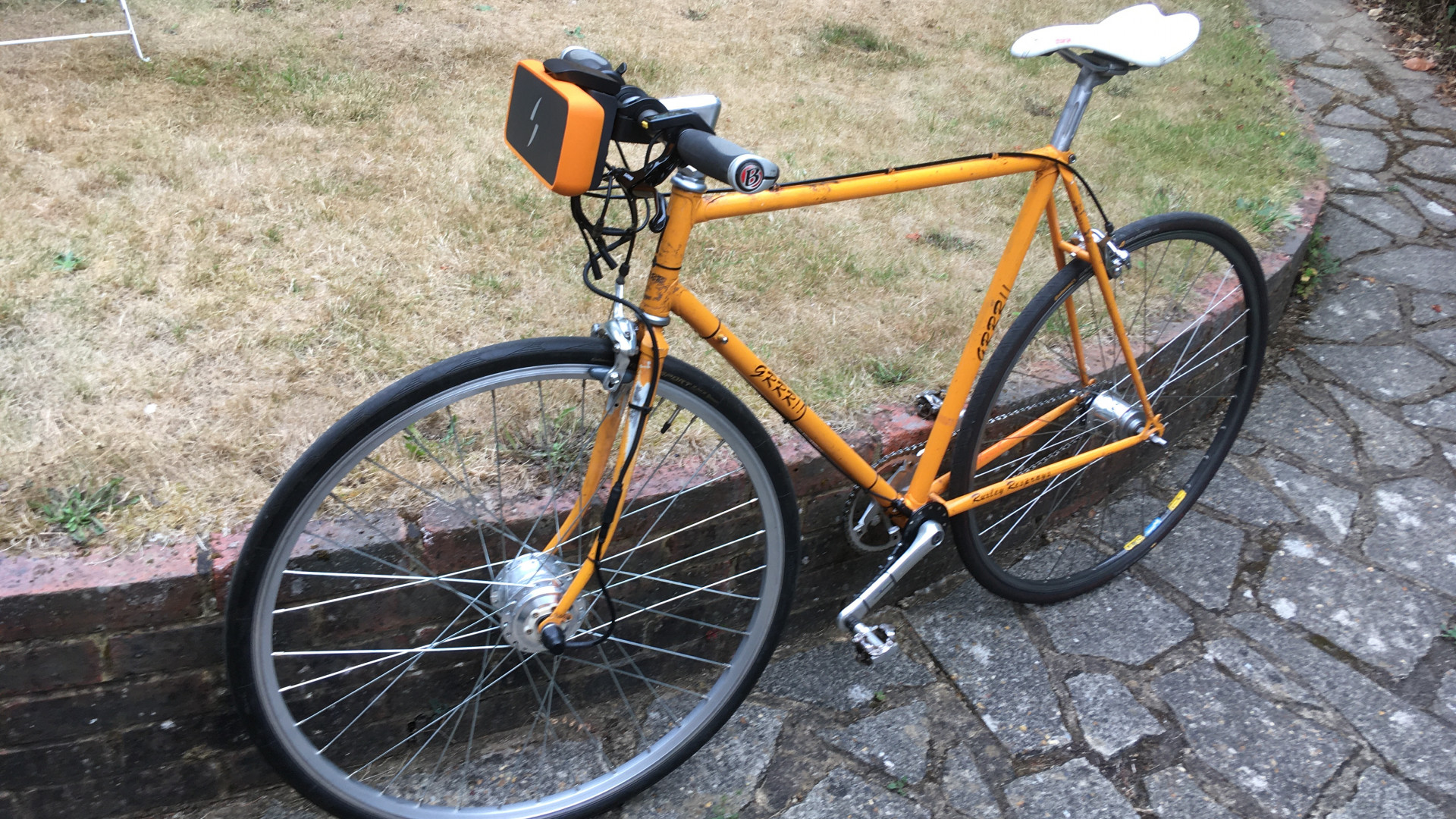 Swytch Max Air Kit ebike conversion kit fitted on a bike
Swytch Max Air Kit ebike conversion kit fitted on a bike
Specifications
- Capacity: Air (98Wh, range 15km) or Max (180Wh, range 30km)
- Torque: 40Nm
- Compatibility: Rim brake and disc brake with 100mm quick release dropouts
- Wheel Sizes: Custom built to your required size
Reasons to Buy
- Very simple to set up
- Sleek design
- Lightweight at 700g (Air) or 1,100g (Max)
Reasons to Avoid
- Shorter range
- Often sold out
8.2. TongSheng TSDZ2 Mid Drive Motor
Why is the TongSheng TSDZ2 a favored mid-drive option? The TongSheng TSDZ2 Mid Drive Motor is a popular choice for those seeking a mid-drive conversion kit due to its lightweight design and compatibility with a wide range of bike designs.
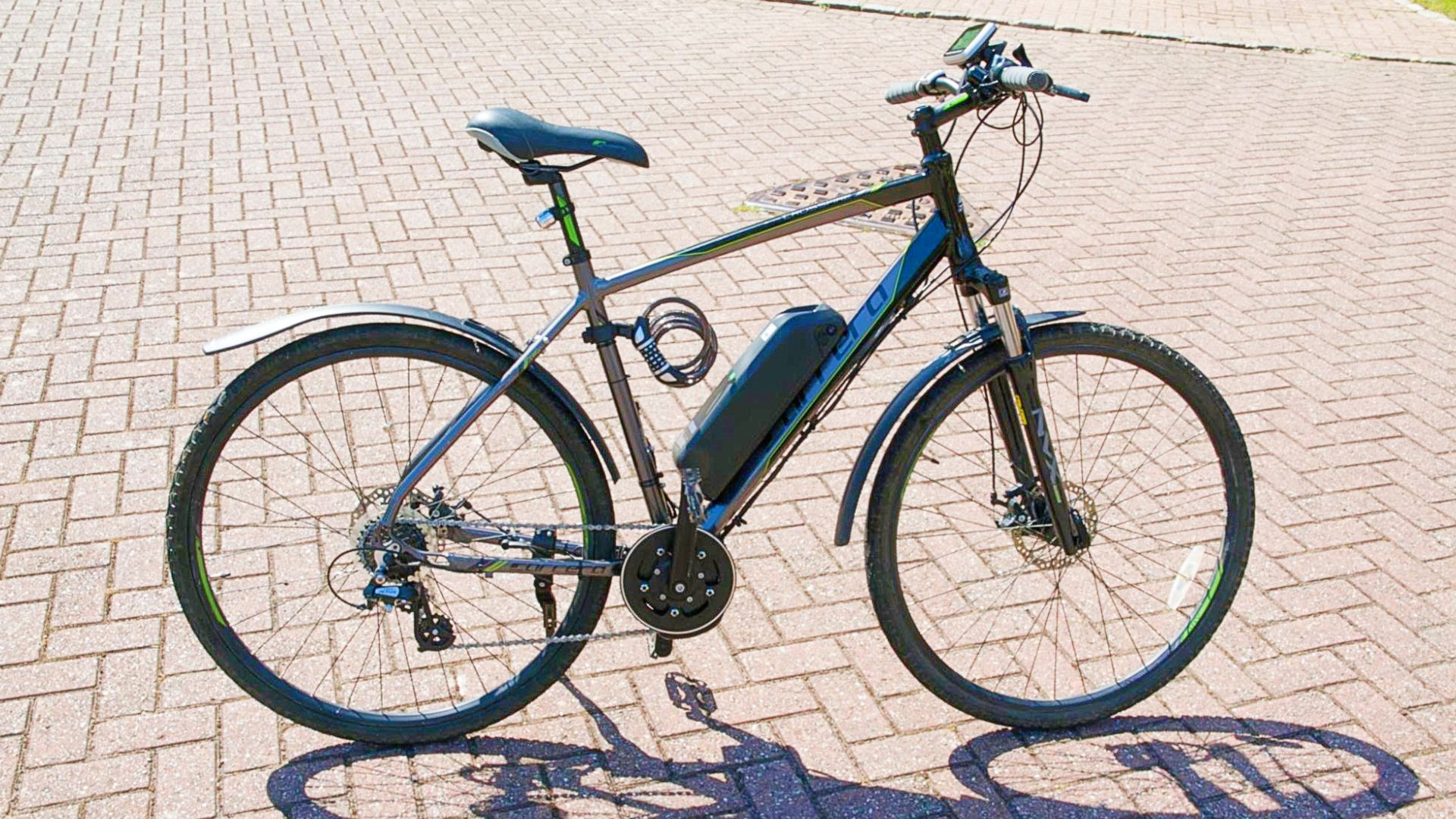 Tongsheng TSDZ2 Mid Drive e-bike conversion kit fitted on a bike
Tongsheng TSDZ2 Mid Drive e-bike conversion kit fitted on a bike
Specifications
- Capacity: Battery sold separately
- Torque: 80nm
- Compatibility: Alloy bikes with bottom brackets 68–73mm
Reasons to Buy
- Lightweight for the power output
- Compatible with a wide range of bike designs
- Better ground clearance
Reasons to Avoid
- Battery must be bought separately
8.3. Voilamart 48V Rear Wheel Kit
What makes the Voilamart kit a budget-friendly choice? The Voilamart 48V rear wheel kit is an affordable option for converting your bike to an e-bike.
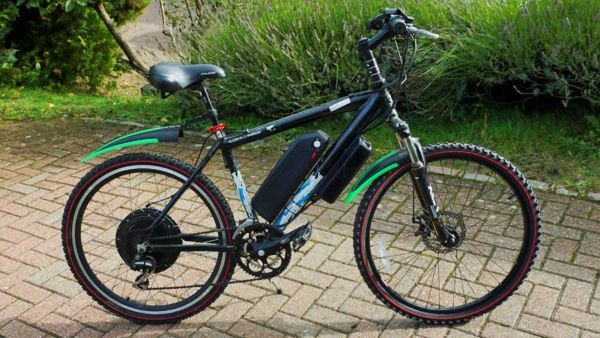 Image shows rear wheel ebike kit fitted to a bike
Image shows rear wheel ebike kit fitted to a bike
Specifications
- Capacity: Battery sold separately
- Torque: 45Nm
- Compatibility: 26″ wheel size
Reasons to Buy
- Inexpensive
- Plenty of power
- Clear and easy to read display screen
Reasons to Avoid
- Some components feel a bit ‘cheap’
- Doesn’t come with a battery
- Requires removal of crank to fit pedal sensor
- Not waterproof
8.4. Skarper DiskDrive System
What advantages does the Skarper DiskDrive offer in terms of compatibility? The Skarper DiskDrive system stands out for its speed of setup and broad compatibility, making it a versatile choice for many bikes.
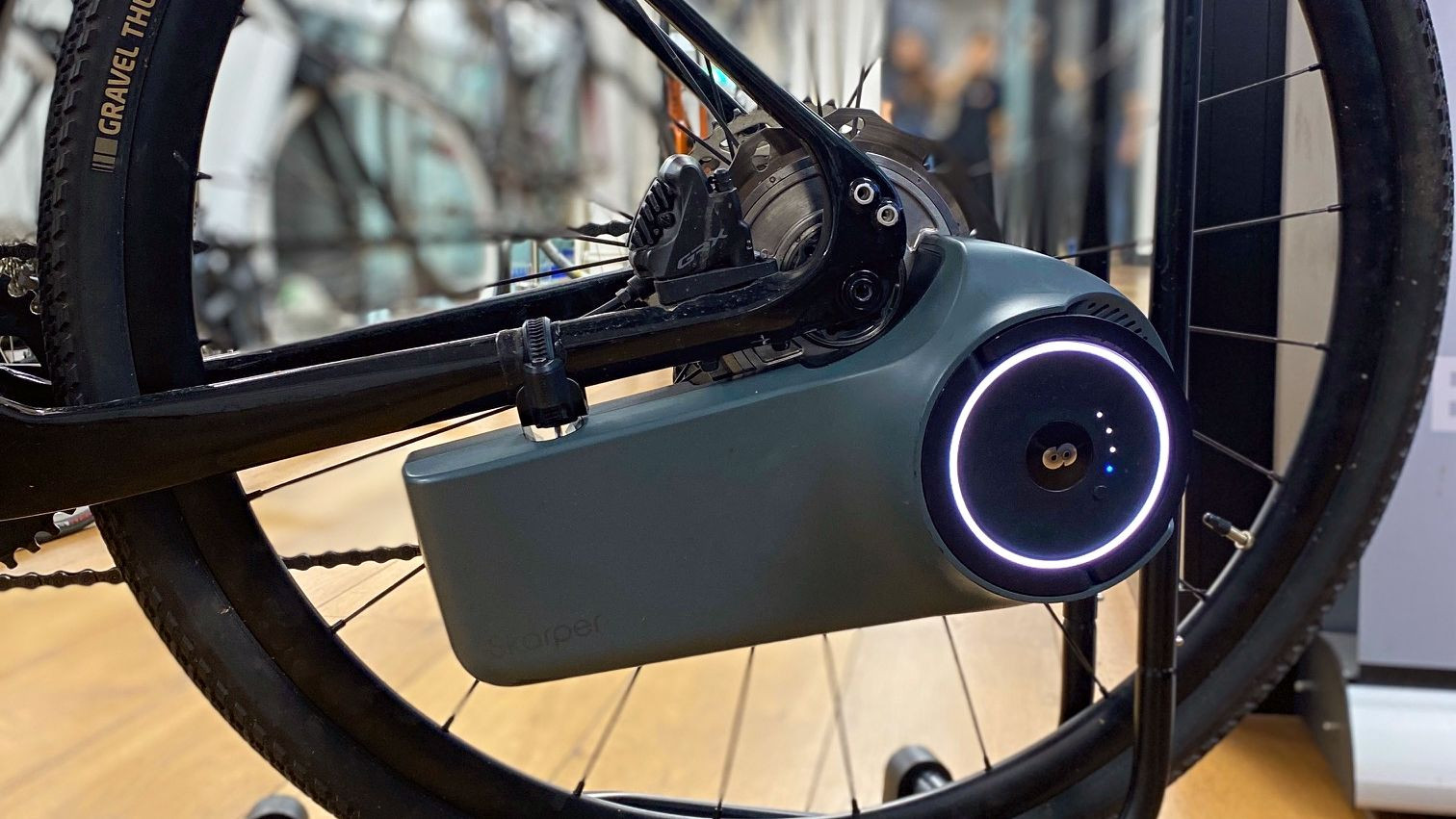 Skarper ebike conversion kit mounted to the rear triangle of a bicycle
Skarper ebike conversion kit mounted to the rear triangle of a bicycle
Specifications
- Capacity: Claimed 50km/31miles in Eco, 30km/18miles in Turbo
- Torque: 45nm
- Compatibility: Any bike with a disc brake
Reasons to Buy
- Cheaper than a complete rear hub Mahle ebike
- Reasonable weight
- Very strong in turbo mode
- Super simple to fit
- Excellent compatibility
Reasons to Avoid
- Considerably more expensive than most ebike conversion kits
- Unproven durability
- Eco mode could be stronger
8.5. Bafang Mid Motor Kit
Why is the Bafang Mid Motor Kit ideal for off-road riding? The Bafang Mid Motor Kit is an excellent choice for off-road riding due to its high torque and efficient power delivery.
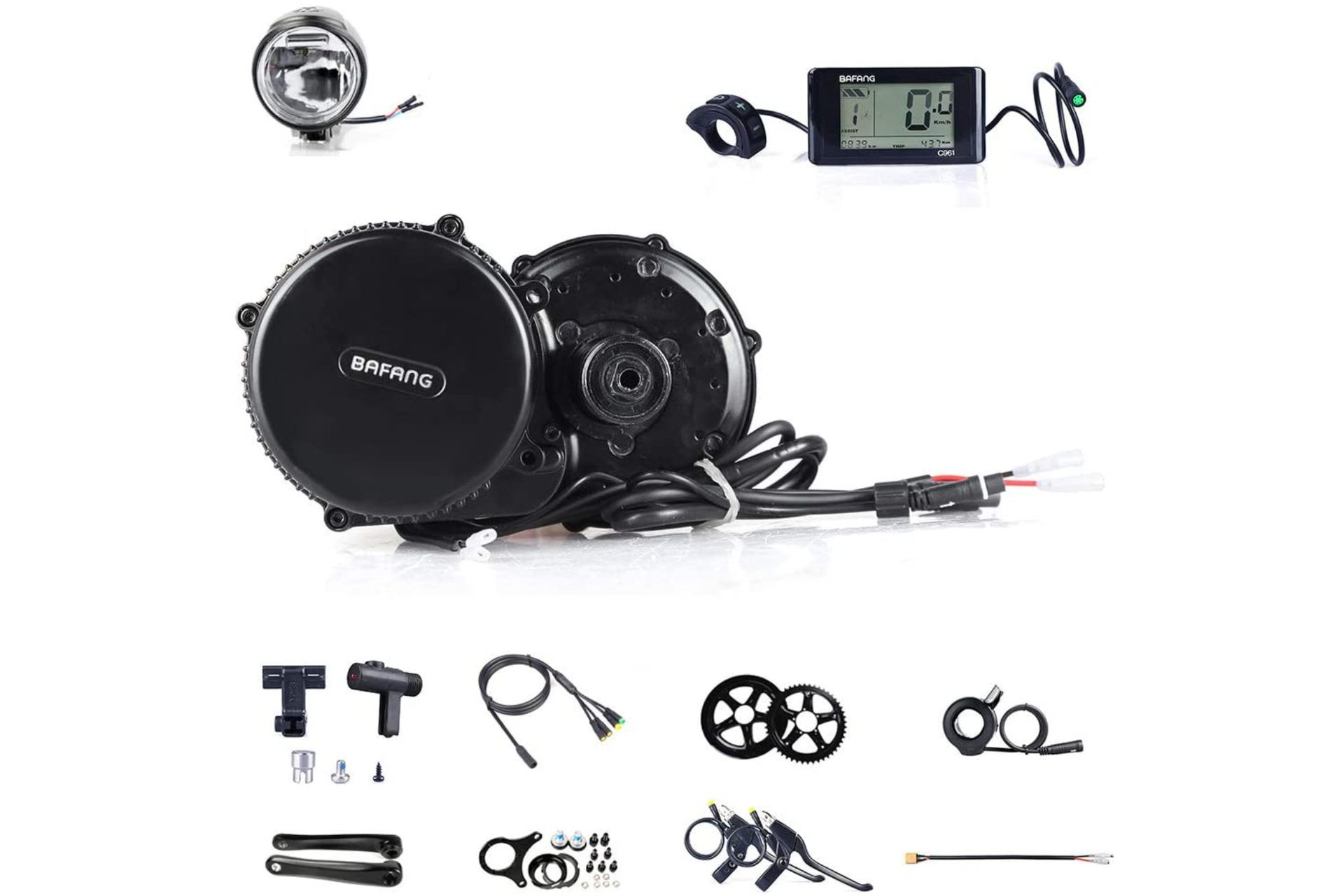 Bafang mid drive which is one of the best electric bike conversion kits
Bafang mid drive which is one of the best electric bike conversion kits
Specifications
- Capacity: Battery sold separately
- Torque: 80Nm
- Compatibility: Alloy bikes with bottom brackets 68–73mm
Reasons to Buy
- Capable off road
- Keep your current wheels
- High torque
Reasons to Avoid
- Low-slung motor doesn’t offer much clearance
- Battery sold separately
8.6. Bafang Front Hub Motor Kit
What are the benefits of choosing a Bafang front hub motor? The Bafang front hub motor kit is a budget-friendly option from a reputable brand, offering good value and ease of setup.
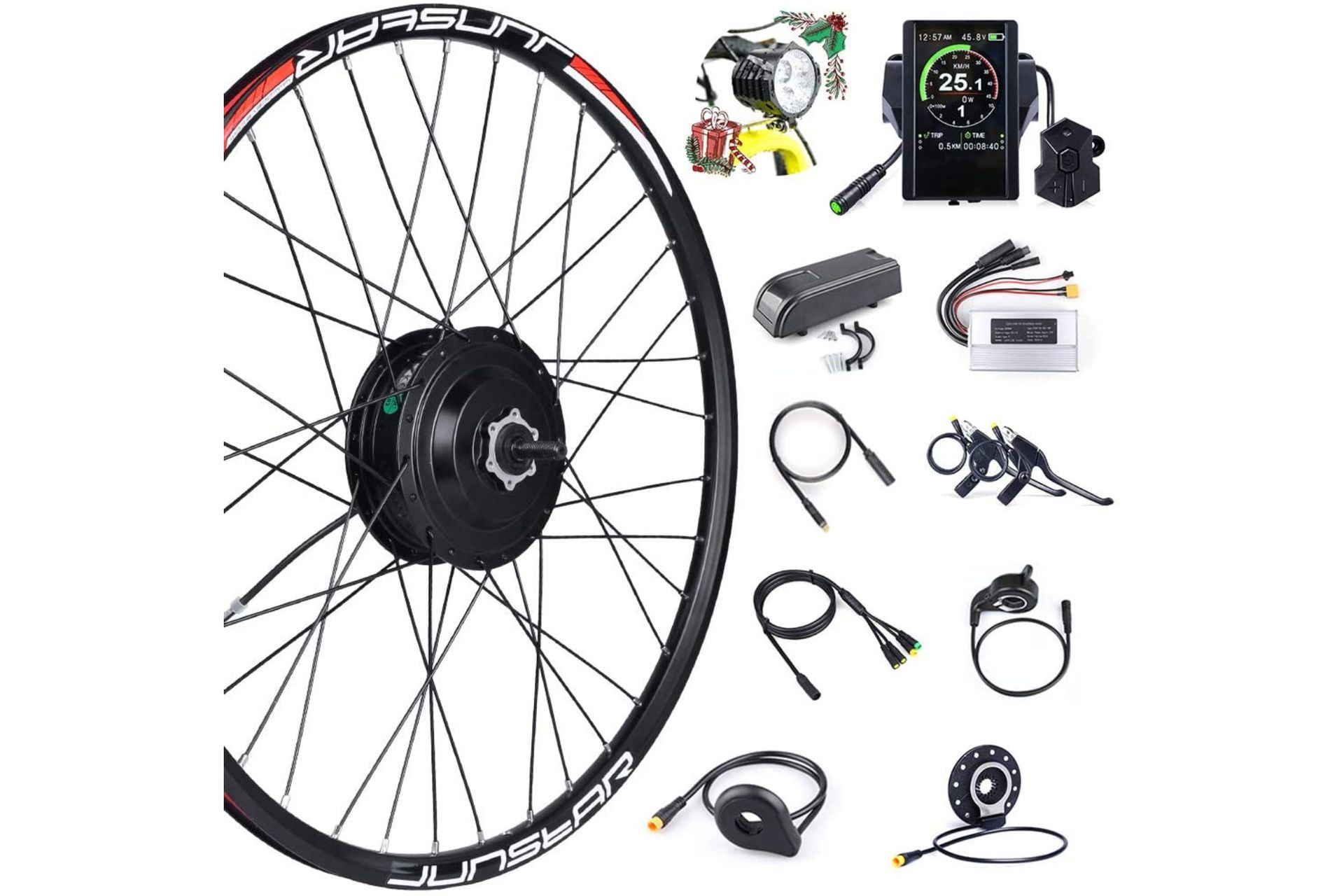 Bafang front hub motor kit which is one of the best electric bike conversion kits
Bafang front hub motor kit which is one of the best electric bike conversion kits
Specifications
- Capacity: 11.6 – 17.5Ah options (45km/28mi – 68/km42mi)
- Torque: 65Nm
- Compatibility: Disc brake with a quick-release axle
- Wheel Sizes: 20″, 26″, 27.5″/650b, 28″/700c
Reasons to Buy
- Good value
- Less bulky
Reasons to Avoid
- Could do with better instructions
9. Legal Considerations and Regulations
What legal aspects should you consider before converting your bike to an e-bike? Understanding the legal considerations and regulations surrounding e-bikes is essential for compliance and safety.
9.1. E-Bike Classifications
What are the different e-bike classifications? E-bikes are typically classified into three classes:
- Class 1: Pedal-assist e-bikes with a motor that assists only when the rider is pedaling, up to a maximum speed of 20 mph.
- Class 2: Throttle-assisted e-bikes with a motor that can propel the bike without pedaling, up to a maximum speed of 20 mph.
- Class 3: Pedal-assist e-bikes with a motor that assists only when the rider is pedaling, up to a maximum speed of 28 mph.
9.2. State and Local Laws
How do state and local laws affect e-bike usage? E-bike laws vary by state and locality. Some jurisdictions have specific requirements for licensing, registration, and where e-bikes can be ridden. Check your local regulations to ensure compliance.
9.3. Power and Speed Limits
What are the power and speed limits for e-bikes in your area? Most jurisdictions have limits on the motor’s power output and the maximum assisted speed. Ensure that your e-bike conversion complies with these limits.
10. Community and Resources for E-Bike Enthusiasts
Where can you find a community and resources for e-bike enthusiasts? Connecting with other e-bike enthusiasts can provide valuable insights, tips, and support.
10.1. Online Forums and Groups
What online platforms can connect you with other e-bike riders? Online forums and social media groups dedicated to e-bikes are great places to share experiences, ask questions, and learn from others.
10.2. Local Bike Shops and Clubs
How can local bike shops and clubs support e-bike owners? Local bike shops and clubs often offer e-bike maintenance services, group rides, and educational resources.
10.3. E-Bike Events and Festivals
Are there any e-bike events or festivals you can attend? E-bike events and festivals provide opportunities to test new products, meet fellow enthusiasts, and participate in organized rides and workshops.
FAQ: Common Questions About E-Bike Conversion
1. Can you convert any regular bike to an e-bike?
Most bikes can be converted to an e-bike with the right conversion kit. Factors to consider include frame material, brake type, wheel size, and dropout spacing.
2. How much does it cost to convert a bike to an e-bike?
The cost varies depending on the type of kit and battery size, typically ranging from $500 to $800 for a reputable brand.
3. Is it worth converting a bike to an e-bike?
Yes, converting a bike is often more cost-effective than buying a new e-bike, and it allows you to customize your ride.
4. How long does it take to install an e-bike conversion kit?
Installation time varies, but most kits can be installed in a few hours with basic mechanical skills.
5. Do e-bike conversion kits affect the bike’s warranty or legal status?
Conversion kits may void the bike’s warranty. Legal status depends on local e-bike laws regarding power and speed limits.
6. What type of motor is best for e-bike conversion?
Hub motors are easy to install and suitable for general use, while mid-drive motors offer better performance for hills and off-road riding.
7. How far can you ride on a converted e-bike?
Range depends on battery capacity, terrain, and assistance level, typically ranging from 20 to 50 miles on a single charge.
8. What maintenance is required for a converted e-bike?
Regular maintenance includes battery care, checking and tightening components, brake maintenance, and tire maintenance.
9. Are e-bike conversion kits safe?
Yes, if installed correctly and used responsibly, with attention to safety measures like helmet use and following local regulations.
10. Where can I find support for my e-bike conversion project?
Online forums, local bike shops, and e-bike clubs are great resources for support and advice.
Conclusion: Electrify Your Ride Today!
Can you put an electric motor on a bike? Absolutely, and with the right knowledge and resources, you can transform your regular bicycle into a powerful and efficient e-bike. By understanding the different types of conversion kits, assessing your bike’s suitability, and following the installation and maintenance guidelines, you can enjoy the many benefits of electric-assisted riding.
Ready to start your e-bike conversion journey? Explore usabikers.net for in-depth reviews, guides, and a vibrant community of fellow bikers. Join us and experience the thrill of the open road with a little extra electric power!
Visit usabikers.net today to discover more about e-bike conversions, connect with fellow enthusiasts, and explore the exciting world of biker culture in the USA. Don’t miss out on the latest articles, reviews, and community discussions. Your next adventure starts here!
Address: 801 Sturgis Main St, Sturgis, SD 57785, United States
Phone: +1 (605) 347-2000
Website: usabikers.net
